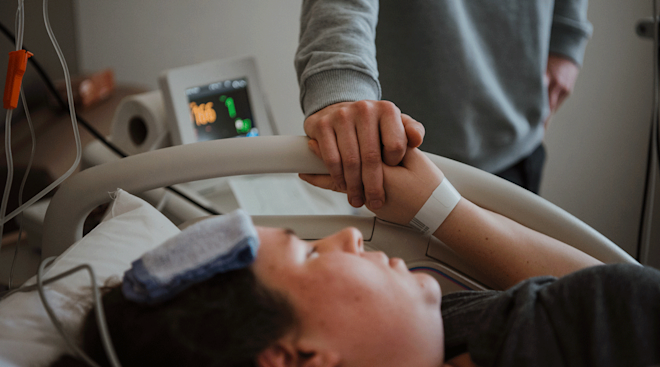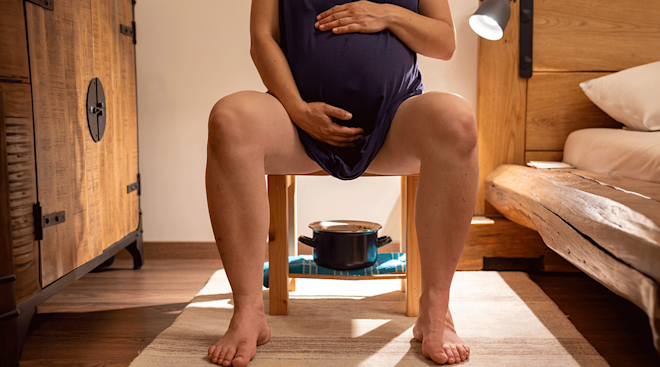What Happens at the Hospital When You Deliver
The day is finally here! It’s time to deliver baby. As exciting as it might feel to finally give birth, you likely also have a lot of questions and concerns about everything from labor progression to post-birth recovery at the hospital. With the help of experts and real moms, we’ll guide you through what you need to know, from the minute you decide to go to the hospital to the moment you finally head home with baby snugly strapped into their car seat.
First things first. Before you set foot in labor and delivery, you’ll need to preregister at your hospital. This means giving them your insurance information and filling out all that boring paperwork in advance, so you’ll have less to do when you get there on the actual day. Then, pack your hospital bag and feel free to nest away while you nervously, and excitedly, wait.
Going into labor
If you’re planning a vaginal birth, chances are you’ll go into labor on your own. (If you’re getting induced, you’ll likely check in before contractions start.) Once you feel signs of labor—repeated contractions that don’t slow down or stop—call your OB. They’ll tell you when it’s time to head to the hospital. “I can always tell on the phone whether a patient is in labor or not. If they’re laughing and talking in a normal tone of voice, I know they’re not,” says Alane Park, MD, an ob-gyn with her own practice in Los Angeles and coauthor of The Mommy Docs’ Ultimate Guide to Pregnancy and Birth. “For the ones who are truly in labor, usually it’s their partners calling because they’re too uncomfortable.”
Arriving at the hospital
When you get to the hospital, go to labor and delivery. There, a nurse will take you into a triage room, hook a fetal monitor to your belly to check baby’s heart rate and measure your contractions. If you or the nurses think your water has broken, you might get a swab (yep, down there) that will be used to test if it really is amniotic fluid. There will be a cervical check too, to see if you’ve dilated and effaced.
At this point, you could be sent home if labor hasn’t progressed enough, Park says. (Total letdown, but don’t worry—you’ll be back.) If your contractions seem strong and your cervix is changing, you’ll be admitted. “There isn’t one thing that says you’re going to have to go home versus staying at the hospital,” says Park. “I use the patient’s clinical history and how she looks to decide.” (If you came in screaming in pain and obviously very far into labor, you would probably be admitted immediately—forget the whole triage thing.)
One thing’s for sure when it comes to giving birth: It pays to prepare for the unexpected. “I had a vaginal birth in an operating room ‘just in case’ we needed to do a C-section for my twins—one was breech,” says Kathy S., account manager at The Knot Worldwide. “One was taken to the NICU immediately. My birth was nothing like I thought it would be, and having my babies away from me in the NICU was not what I had dreamed about. But being able to roll with the punches and expect the unexpected was so important to keeping myself calm and making my birthing experience as joyful as possible!”
In the delivery room
Time to take off your clothes and put on a super-stylish hospital gown. A labor and delivery nurse will be assigned to you—they’re your point person as you progress through labor.
What happens next depends on how you plan to manage pain. If you’re going medication-free or would like to wait before getting an epidural, you may want to walk around or take a shower or bath, if your hospital has tubs, to deal with the pain. Nurses will put the monitors on you periodically to check on baby’s heart rate and your contractions. Keep in mind that it’s totally okay to change your original pain-management plan as labor progresses, says Christine Greves, MD, FACOG, an ob-gyn at the Winnie Palmer Hospital for Women & Babies in Orlando. “[If] it hurts too much and you change your mind, you’re definitely still a hero! No judgment,” she says.
If you want to go the epidural route, there’s no specific time when you have to request it. Just know you might have to wait a bit for an anesthesiologist—most likely about 30 to 45 minutes from when you make your request—before you’re actually pain-free, says Park. Once the epidural has been administered, you’ll receive continuous monitoring, which means you’ll stay in bed with the monitors attached to your belly. You may also get an IV to provide fluids, so you don’t get dehydrated. Also be warned that having an epidural means having a catheter to empty your bladder as well—some moms-to-be are surprised to hear that. Another option is IV medication that can take the edge off your pain instead of the epidural.
Labor progression
At this point, your OB may have come in to check on you, but there’s no real guarantee of when you’ll first see your doctor. It could be close to the time you check in or not until it’s time to push. It depends on what time of day it is, whether they’re already at the hospital (or at home or at their office) and what’s happening with their other patients. For most of labor, you’ll be with whoever you’ve chosen to bring along with you: your partner, doula (if you’re hiring one) or another support person.
Over what will likely be hours and hours—every mom is different and first-time labors typically take the longest—contractions will become intense and close together. You might find after a while that there’s a lot of pressure, sort of like having to go number two but worse! That’s the urge to push. Hit the call button, or send your support person to track down your nurse or doctor because it’s almost time. But don’t push yet! The OB has to check and make sure you’re 10 centimeters dilated, so you don’t injure yourself while pushing.
There are a few instances—such as if there’s fetal distress or your cervix stops dilating—in which your doctor might call for an emergency C-section. If this happens, make sure to read the section about Cesarean births below.
Push coming to shove
It could be three pushes or 30. Listen to your provider’s guidance—they’ll tell you when to push hard or not so hard and can help guide baby’s head out. Then, you’re a mom!
Now what?
In most cases, the doctor will put baby on your chest directly after birth, as long as there aren’t any issues with baby’s breathing, color or tone, Park says. If there’s an issue, they’ll put baby on a warmer in the room and call the NICU so they can help resolve it.
In the meantime, you’ll deliver the placenta, which typically takes less than 30 minutes in a full-term pregnancy, says Greves. Your doctor will then determine whether you need stitches to repair any vaginal tears. “First, we assess what type of repair is needed, and what tissues are involved,” says Greves. “After that, we call for our sutures to approximate the tissue and help with the bleeding. Usually the stitches are dissolvable, so no need to worry.” Greves adds that it’s very important to allow your body to “heal completely before having sex or [putting] anything inside the vagina”; typically around six weeks.
Usually, mom and baby stay in the delivery room for about two hours after birth to make sure baby’s transitioning to “life on the outside” well and that you’re doing well too—no excessive bleeding and stable vital signs. During this time, baby will be weighed and an Apgar score will be taken. Then you and baby will be taken by wheelchair to your postpartum room.
Scheduled C-section
If you need to schedule a C-section for medical reasons, don’t worry—it’s not like trying to get a reservation at that new, trendy restaurant. Your doctor’s office will likely set up the appointment themselves and tell you when to show up at the hospital—about two hours before your procedure is scheduled to begin. (Of course, it might not start on the dot of your reserved time. “Labor and delivery is a little bit of a minefield,” says Park. “You can’t always plan everything to a tee.”)
Keep in mind that in some cases, scheduled C-sections can turn into unscheduled ones because you start going into labor. “I went into labor two days before my scheduled C-section, so we had to rush to the hospital where I found out that I was already 5 centimeters dilated,” says Natalie G., senior editor at The Bump. “I was nervous that things weren’t going to go as planned, but my team of nurses, anesthesiologist and doctor were extremely on top of things and respectful of my original plan. I had a similar experience to a scheduled C-section; just at 5 a.m. and having already felt quite a few contractions!”
Cesarean prep
The procedure itself will probably take 30 minutes to an hour, although timing can depend on your surgical history, says Greves. If it’s an emergency C-section, you may have already had an epidural. If it was planned, you might get a spinal block. An anesthesiologist will come in and ask you about any medical problems before administering your pain meds.
Your pubic hair will be clipped as necessary, since most doctors make the incision pretty low on the abdomen, and you’ll need an IV (for fluids and medications) and catheter (to empty your bladder, since you’ll be too numb to walk to the bathroom).
The procedure
You’ll lie awake with a curtain blocking the surgery itself—and you may feel some pressure, pushing and tugging as the doctor makes the incision and guides baby out. “You shouldn’t feel any pain,” Park says.
Then comes the exciting moment: baby’s birth. If baby’s doing well, they’ll be shown to you quickly before heading off to a warmer in the room—that’s because baby needs to be assessed and stabilized, and you need to be sewn up and able to sit up before you can hold them. The time will come soon for you to meet!
In the recovery room
After you’ve got a new person in your life, you’ll head to a recovery room, where you and baby will set up camp. A nurse might also occasionally offer to take baby to the nursery while you shower or get some sleep—this is totally up to you.
You’ll likely stay in the hospital for two days after vaginal birth and three or four days after a C-section. Your provider will see you every day until you go home, and a pediatrician will check in on baby daily too.
Healing and bonding
During this time, you’re going to be super-sore. Drink lots of fluids, eat healthily and focus on feeding and bonding with baby. If you feel overwhelmed or have questions, ask your postpartum nurses or lactation consultants for help or advice—that’s what they’re there for. “Take all the time you need in the hospital,” says Karen K., a member of The Bump Facebook community. “Ask all the questions you can think of. Those nurses are baby experts and generally happy to share their knowledge.”
With a C-section delivery, your biggest issue is likely to be pain where you had your incision. Your doctor will give you painkillers to take. Make sure you don’t lift anything heavier than your baby or do anything strenuous for four to six weeks. “It might take longer to recover from a C-section than you imagined,” says Natalie G. “Make sure you have people to delegate tasks to, and don’t be afraid to ask for help. One thing I didn’t expect was that I didn’t have the same mobility for a few days after being discharged from the hospital—I had to walk super slowly, for example. Take it one day at a time and don’t try to do too much, and you’ll heal faster. Also, take all the free stuff home from the hospital that you can! You’ll need all that disposable postpartum underwear and all those diapers.”
Please note: The Bump and the materials and information it contains are not intended to, and do not constitute, medical or other health advice or diagnosis and should not be used as such. You should always consult with a qualified physician or health professional about your specific circumstances.
Plus, more from The Bump:
Christine Greves, MD, FACOG, is an ob-gyn at the Winnie Palmer Hospital for Women & Babies in Orlando. She received her medical degree from the University of South Florida College of Medicine.
Alane Park, MD, is an ob-gyn with her own practice in Los Angeles and coauthor of The Mommy Docs’ Ultimate Guide to Pregnancy and Birth. She earned her medical degree at the Keck School of Medicine of the University of Southern California and went on to complete a residency at LAC+USC Medical Center.
Lamaze International, Labor Day: What to Expect
NewYork-Presbyterian, Postpartum Care
Learn how we ensure the accuracy of our content through our editorial and medical review process.
Navigate forward to interact with the calendar and select a date. Press the question mark key to get the keyboard shortcuts for changing dates.




















































